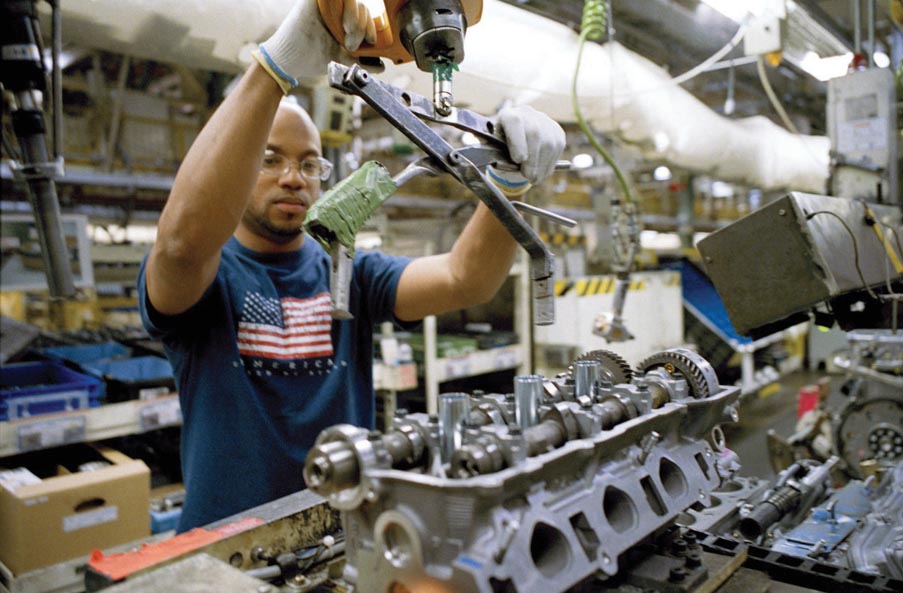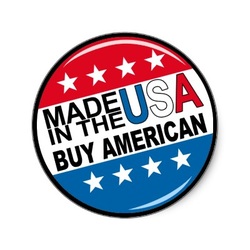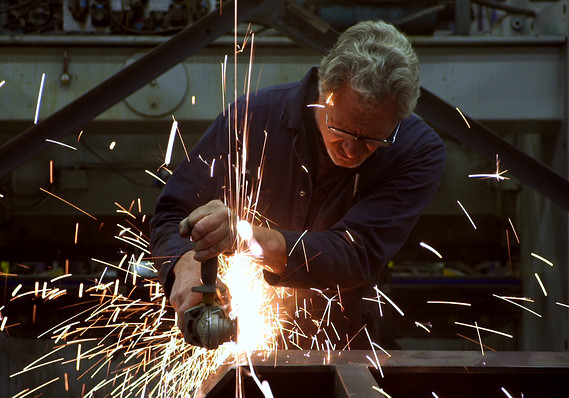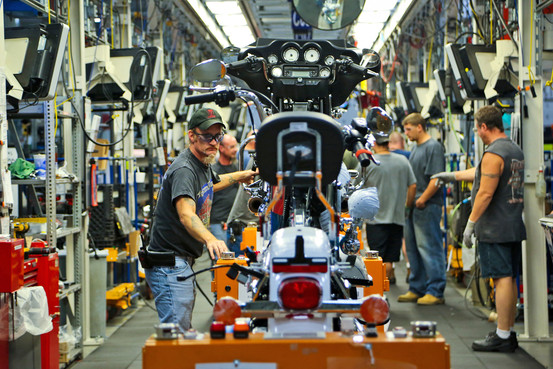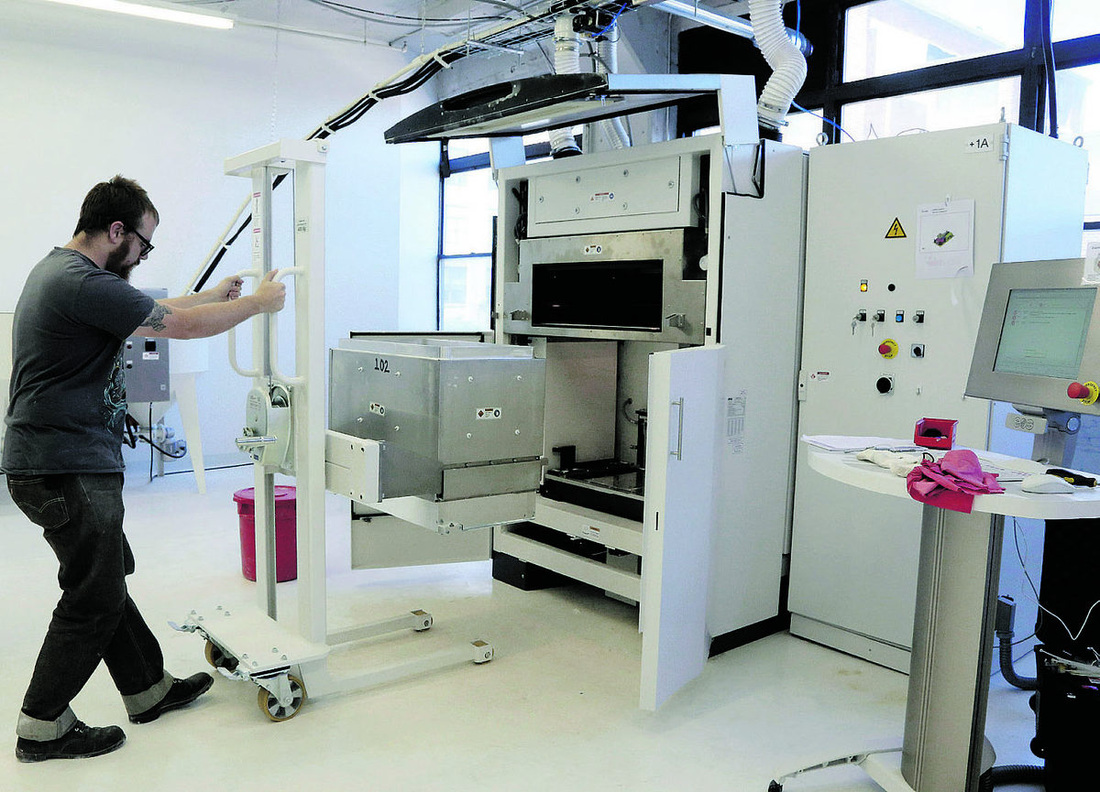Dallas Fed President Richard Fisher has long complained that U.S. politicians have undermined the economic recovery, and he reiterated that message in a speech that nonetheless remained hopeful that American manufacturers could yet become the “most efficient operators in the world.”
A policy hawk who has said the central bank will likely trim its bond-buying program next month, Fisher said little about Fed policy on Thursday except that companies in general have benefited from the monetary accommodation.
In a speech where he compared U.S. manufacturing to the race horse Secretariat, Fisher said the sector could be helped by “throwing out old, counterproductive fiscal and regulatory policies” that would allow manufacturers to outpace their global competition.
“American companies … have taken advantage of the cheap and abundant money made available by the Fed’s very accommodative monetary policy to create lean and muscular balance sheets,” he told a manufacturing conference, according to prepared remarks.
“While there are many risks in the policy that the Fed has been pursuing … every manufacturer of goods in America has been given a great gift by your central bank,” Fisher said.
The Fed has kept interest rates near zero since 2008 and more than tripled its balance sheet to some $3.6 trillion in an unprecedented effort to lower borrowing costs and encourage investment, hiring and growth.
But the recovery has been erratic and growth has remained below 2 percent this year thanks in part to tighter fiscal policies.
While U.S. manufacturing production took a beating in the 2007-2009 recession, it has rebounded in recent years and the latest monthly data show factory activity jumped to a two-year high in July.
“The remaining obstacle to being the absolute best economy for manufacturers and other businesses, bar none,” Fisher added, “has been fiscal and regulatory policy that seems incapable of providing job-creating manufacturers and other businesses with tax, spending and regulatory incentives to take advantage of the cheap and abundant fuel the Fed has provided.”
According to the Boston Consulting Group (BCG), the U.S. is fast becoming one of the lowest-cost countries for manufacturing in the developed world. BCG argues that average manufacturing costs in Germany, Japan, France, Italy, and the U.K. will be 8 to 18 percent higher than in the U.S. by 2015.
The report states that export manufacturing in the U.S. is a unsung hero of the economic recovery, noting: “Despite all the public focus on the U.S. trade deficit, little attention has been paid to the fact that the country’s exports have been growing more than seven times faster than GDP since 2005.”
BCG found that the U.S. is increasingly attractive for businesses due to lower costs of labor, (adjusted for productivity), natural gas, and electricity.
U.S. manufacturing activity hit a five-month high in August as hiring picked up and new orders increased at their fastest pace since January, a Markit report showed last Thursday.
However, BCG’s report argues that we are currently just witnessing the beginning of a major shift in global manufacturing.
“Over the past 40 years,factory jobs of all kinds have migrated from high-cost to low-cost countries,” said Harold L. Sirkin, co-author of the report. “Now, as the economics of global manufacturing changes, the pendulum is finally starting to swing back. In the years ahead, it could be America’s turn to be on the receiving end of production shifts, as more companies use the U.S. as a low-cost export
BCG believes the U.S. will capture between $70 billion and $150 billion in annual exports from other nations by 2020, with two-thirds of these export gains emanating from production shifts to the U.S. from leading European nations and Japan.
Furthermore, by 2020, with more production work shifting back to the U.S. from China, between 2.5 million and 5 million American factory and service jobs could be created. BCG believes that would mean the U.S. unemployment rate could drop by up to three percentage points from its current rate of 7.4.
Chris Williamson, chief economist at Markit, agreed with the BCG’s findings, though questioned the reliability of the time-frame of when America would emerge once more as a cheap,manufacturing powerhouse, and the precise effect it would have on the wider economy.
“It’s difficult to gauge the extent to which the U.S. economy will benefit and over what time scale,”he said, adding, “It is becoming increasingly evident that many companies are shifting production back to the U.S. from low-cost countries, notably China, as the advantages of having a production base in these countries fades or are re-evaluated.”
The BCG’s report references a number of foreign companies, such as Toyota, Airbus, Yamaha, Siemens and Rolls-Royce, who have already started to move more of their production facilities to the U.S.
While BCG cited low labor, natural gas and electricity costs, Williamson emphasized lead-times. “Before, a lengthy, six-month transport time for goods to be shipped from Asia could be tolerated given the cost advantage,” Williamson said. “But,as the cost advantage fades, the trade-off between cost and timeliness works in the latter’s favor. With the increasing use of 3-D printing, this trade-off will of course work even more in favor of localized production.”
Indeed, Mary Anne Greczyn, a spokesman for Airbus, said this was why the aircraft manufacturer was opening a factory in Mobile, Alabama.
“As you would imagine, for an airline such as JetBlue or American Airlines to have to come to Europe every time they get an aircraft delivered can be time- and resource- consuming,” Greczyn said. “When the new facility in Mobile is up and running, they will need only to travel to Alabama for their A320 Family aircraft.”
Greczyn added that Airbus was not moving, shifting or reshoring construction to America, but simply expanding its production facilities.
Williamson broadly agreed with the BCG report, but warned that it would be many years before the “renaissance” of the goods-producing sector in the U.S.
Last week, Walmart expanded on the $50 billion Buy American pledge it made last January with a full-fledged Made-in-America summit.
Unfortunately, manufacturing in the United States has lost competitive advantage in the last 15 years and unless this turns around significantly it will continue to be a drag on our efforts to fully recover from the Great Recession.
There is no inherent reason the United States could not run a significant trade surplus in manufacturing. America possesses the tools, talent, and resources to revive industrial production and our innovation economy.
Read the rest of the article here: http://www.industryweek.com/competitiveness/why-america-needs-national-manufacturing-strategy?goback=.gde_4765254_member_267015572#%21
Wal-Mart, known for buying the lowest-cost goods wherever they are made, has become a lightning rod for community leaders worried about the hollowing-out of America’s industrial base.
But at Wal-Mart’s Manufacturing Summit held in Orlando, Fla., late last week and attended by 1,500 government officials, suppliers and retailers, the company said it sees a future for U.S. manufacturing.
“At the summit, we are building a network of support for domestic manufacturing,” Simon said. “In the room, we have the capital, the expertise, the ideas, and, most importantly, the will.”
Buying in U.S. good PRCBC business commentator Michael Hlinka dismissed the pledge to buy American as “pure PR” motivated by a political climate in which it is seen as good business to invest in the U.S.
“Wal-Mart has been a wonderful organization with a shark-like focus that says whatever is the lowest price, that’s what we’re going to do,” he said on CBC’s Metro Morning.
“Wal-Mart has been criticized about its procurement policies. It generates about two-thirds of its revenue in the U.S., and there is no way, when you step inside a store, you’re going to see two-thirds of the products are built in North America.”
He points out that with sales of $250 billion a year, Wal-Mart’s pledge to buy $50 billion in U.S. goods over 10 years amounts to less than two per cent of its sales.
‘Buying American’ won’t translate into jobsStacy Mitchell, a researcher with the U.S.-based Institute for Local Self-Reliance, says for Wal-Mart, buying American will be a byproduct of its continued takeover of the U.S. grocery business.
Most grocery products sold in the U.S. are produced in America, and Wal-Mart will be buying more U.S. foods, particularly produce, as it displaces other grocers, she says.
“But this doesn’t mean new jobs, because other grocers are losing market share and buying less,” Mitchell said in an article for AlterNet.
She recalled Wal-Mart’s 1980s “Buy America” program, which occurred as the retailer was moving to do most of its acquisitions overseas.
But business analysts at the Wal-Mart summit say the low-cost manufacturing havens such as China are losing their competitive edge. As workers in developing nations demand higher wages and the cost of transporting goods increases with the cost of oil, it becomes cheaper to buy U.S.-made goods.
Among the businesses who say they are manufacturing in the U.S. are:
- GE, which produces energy efficient soft white lightbulbs in the U.S. for Wal-Mart.
- The makers of No nonsense and Renfro socks.
- Element Electronics Corp., which will open a new flat screen TV factory in Winnsboro, S.C., by December 2013.
“Right now, companies in America are making and selling products around the world at an all-time record pace, and the incentives to make things here and hire American workers is only getting stronger,” U.S. Secretary of Commerce Penny Pritzker Pritzker told the summit.
But for manufacturing to succeed, the business community, institutions of higher education, policymakers and consumers need to make some major changes.
Many of us have the image of a post-World War II-era assembly line, but times have changed and our modern facilities require individuals that can work with sophisticated machinery. In fact, as we toured 32 cities in 32 days on our American manufacturing bus tour, the majority of manufacturers from towns like Tupelo, Miss., and Warren, Penn., complained that there are jobs available but there is a lack of eligible candidates with specialty degrees who are trained to work for the factories.
So, how do we educate and train young adults to be workforce-ready?
Jobs are a key barometer for the economy. Twenty years ago, U.S. manufacturers employed 17 million Americans; today that number stands at 12 million. To compete with these steadily dropping numbers, we need to provide the apprenticeship training necessary for a new generation of American worker to grow as fast as our technology is changing.
And there are innovative schools out there that are teaching young adults the skills necessary to operate new machinery and programs. In schools like Ranken Technical College in St. Louis, Mo., students are being trained on cutting-edge equipment for jobs in the construction and manufacturing industries.
The proof is in the data. These schools have a nearly 98% placement rate and often work with local businesses to employ graduates in hometown companies.
Although education leads to employment, consumers have to be willing to buy American.
Free-range chickens, local oranges and organic avocados in your grocery store. We are largely conscious consumers in that we increasingly research where our food is produced, yet too many Americans don’t take the time to research and demand their t-shirts, jeans and everyday living necessities are made domestically. And some of this burden falls on the manufacturers and storeowners who need to promote the “Made in America” brand.
The perfect example of a major company producing in America is the athletic shoe company New Balance that employs about 1,300 workers in New England alone. While critics make the claim that American-made products are more expensive, New Balance sneakers are competitively priced to foreign-made shoes like Nike.
But what role does Washington D.C. have in this movement? Better yet, what should they be doing to keep jobs in America?
Instead of burying the responsibility in the halls of the U.S. Department of Commerce, we agree with many scholars and thought leaders that there should be a separate agency focused on manufacturing.
A U.S. Department of Manufacturing could create national standards, guidelines and incentives for manufacturers.
As filmmakers, we get tax incentives for making our movies in certain states. Why not do the same for manufacturing companies? Tax incentives would keep U.S. companies from outsourcing and lure jobs back from overseas. In fact, this idea of bringing companies back to America would help bring almost five million jobs to our shores by 2020, reducing our stagnant unemployment rate by three percentage points.
And some — unfortunately, few — are fighting for U.S. jobs in the Halls of Congress.
Scott Paul, president of Alliance for American Manufacturing, a partnership made up of American manufacturers and the United Steelworkers union, has offered great ideas on how to improve our manufacturing policy overseas. He’s called for a refocus on “trade agenda by giving American businesses new tools to counter China’s currency manipulation, industrial subsidies, intellectual property theft and barriers to market access.”
Our country is eager to re-energize U.S. manufacturing and in some towns they are already taking the necessary steps. We are hopeful that success stories slowly coming out of our small and large cities will help motivate a united effort by consumers, educators, the business community and policy makers to bring jobs back to America.
Vincent Vittorio and Nathan McGill are directors of the upcoming documentary “American Made Movie,” premiering nationwide on Aug. 30 .
The U.S. deficit on trade of manufactured goods in this year’s first half shrank to $225 billion from $227 billion a year earlier, according to data compiled by Ernest Preeg, an economist and trade expert at the Manufacturers Alliance for Productivity and Innovation, an industry-funded research group in Arlington, Va. The improvement, while slight, came after years of ballooning deficits as the U.S. lost manufacturing business to China, South Korea and other nations.
“It’s a hopeful sign,” said Mr. Preeg, who derives his tally of manufactured-goods trade from official U.S. data, leaving out other types of merchandise, such as grain or coal. “At least we’ve leveled off.”
The overall U.S. trade deficit, meanwhile, narrowed recently, as new shale-drilling technologies have sharply boosted domestic energy production.
At present, about 12 million Americans are directly employed by manufacturers, down from nearly 17 million two decades ago. The Obama administration has made a manufacturing recovery a top priority, and major corporations are striving to showcase their efforts to create manufacturing jobs. On Thursday, Wal-Mart Stores Inc. is due to host 500 suppliers in Orlando, Fla., to discuss its “commitment to leading an American renewal in manufacturing” by buying more U.S.-made goods.
Europe’s long-running slump, slower growth in China and a stronger dollar have been headwinds for U.S. exporters, but many have managed to expand overseas sales.
Harley-Davidson Inc. continues to add dealers abroad. “We’re very excited about the growth prospects in our international businesses,” John Olin, chief financial officer, told analysts last month. The Milwaukee-based company recently said retail motorcycle sales jumped 12% in the Asian-Pacific region and 39% in Latin America in the second quarter.
Like many U.S. manufacturers, Harley since the 2008-09 recession has revamped its operations to create a smaller and more flexible workforce, resulting in annual cost savings of more than $300 million and making the company more competitive. Among the changes: The union at its plant in York, Pa., accepted the use of temporary workers, who can be dismissed without severance pay. The number of job classifications at York also fell to five from 62, so workers have a wider variety of skills and can go where needed. As restrictive working rules were eliminated, a 136-page labor contract was replaced by a 58-page document.
Evan Smith, president of Hanover, N.H.-based Hypertherm Inc., said sales of its metal-cutting tools have been growing this year in the Middle East and Latin America. Opening a distribution center in Brazil helped, he said.
Minneapolis-based Graco Inc. has increased sales in Central and Eastern Europe of equipment used to spray paint and other coatings on roads, bridges and buildings, said spokesman Bryce Hallowell.
Big companies, such as Caterpillar Inc. and General Electric Co., have moved some production back to the U.S. in recent years. Some foreign companies, such as tire maker Bridgestone Corp. of Japan, have expanded U.S. capacity, partly to serve customers in the Americas.
As the boom in shale “fracking” lowers natural-gas and electricity prices in the U.S., and wages stagnate, “the U.S. is steadily becoming one of the lowest-cost countries for manufacturing in the developed world,” the BCG report said. The U.S. will have an edge over rival manufacturing nations in energy costs, along with lower productivity-adjusted labor costs than Germany, Japan, France, Italy and Britain, the report said. That will allow the U.S. to grab a larger share of global manufacturing sales.
“This is a fundamental economic shift,” said Harold Sirkin, a senior partner at BCG, who helped write the report. “The trends are going faster than we thought,” he said, adding: “As much as people say we don’t make anything anymore, it’s just not true.”
Even so, the U.S. has lost much ground over the past 15 years, largely because of China’s surging growth and focus on exports. The U.S. accounted for 11% of global exports of manufactured goods in 2011, down from 19% in 2000, Mr. Preeg said. During the same period, China’s share rocketed to nearly 21% from 7%, and the European Union slipped to 20% from 22%.
China’s performance has cooled recently. U.S. exports of manufacturing goods to China surged 19% to $19.9 billion in the second quarter, Mr. Preeg said, but that is about one-fifth of China’s manufacturing exports to the U.S.
U.S. manufacturers still face big hurdles. Many can’t find enough skilled workers to operate and repair sophisticated computer-controlled machinery, a shortage worsened by the retirement of baby boomers. Faster economic growth in China, India and Brazil means many global companies still want to open more plants there. A U.S. corporate focus on quarterly results sometimes deters investment in factory equipment, while many U.S. firms say they pay higher taxes and get fewer subsidies than foreign rivals.
Meanwhile, China no longer relies heavily on labor-cost advantages to get a leg up on other countries. As wages rise, China has shifted to more exports of higher-tech items, including telecommunications equipment, computers and scientific instruments, Mr. Preeg said. Only about 15% of China’s manufacturing exports are in labor-intensive industries, such as textiles or shoes, he said.
Write to James R. Hagerty at bob.hagerty@wsj.com
A version of this article appeared August 19, 2013, on page A1 in the U.S. edition of The Wall Street Journal, with the headline: Manufacturers Gain Ground.
Healthy people infected with Salmonella should monitor themselves for some or all of the following symptoms: nausea, vomiting, diarrhea or bloody diarrhea, abdominal cramping and fever. Rarely, Salmonella can result in more serious ailments, including arterial infections, endocarditis, arthritis, muscle pain, eye irritation, and urinary tract symptoms. Consumers exhibiting these signs after having contact with this product should contact their healthcare providers.
Pets with Salmonella infections may be lethargic and have diarrhea or bloody diarrhea, fever, and vomiting. Some pets will have only decreased appetite, fever and abdominal pain. Infected but otherwise healthy pets can be carriers and infect other animals or humans. If your pet has consumed the recalled product and has these symptoms, please contact your veterinarian.
This issue is limited to the specific dry pet food lot codes listed below. This affects roughly one-tenth of one percent (0.1%) of total annual production. The affected product was distributed to select retailers across the United States. These products were made during a 10-day window at a single manufacturing site. P&G’s routine testing determined that some products made during this timeframe have the potential for Salmonella contamination. As a precautionary measure, P&G is recalling the potentially impacted products made during this timeframe. No other dry dog food, dry cat food, dog or cat canned wet food, biscuits/treats or supplements are affected by this announcement.
P&G is retrieving these products as a precautionary measure. Consumers who purchased a product listed below should stop using the product and discard it and contact P&G toll-free at 800-208-0172 (Monday – Friday, 9 AM to 6 PM ET), or via website at www.iams.com or www.eukanuba.com. Media Contact: Jason Taylor, 513-622-1111.
Contact:
Procter & Gamble
P&G Consumer Relations, 800-208-0172
However, in 2002, the Defense Department began bypassing the Berry Amendment’s requirements for footwear by issuing cash allowances to new recruits to purchase any kind of training shoes, including non-American-made footwear. The DoD has spent approximately $180 million on the athletic footwear cash allowance to date, which is money that could have gone to support American jobs and manufacturing.
Defense originally justified the allowance program by citing a lack of American-made options in the marketplace. They believed there simply were not enough footwear manufacturers producing 100 percent American made shoes.
Today that argument has been upended by companies that have devoted money and resources to producing their footwear completely on American soil.
New England’s own New Balance has proven it can be done. With multiple facilities around the region that employ thousands of New Englanders, including 800 employees in Massachusetts and nearly 900 in Maine, they are making sneakers from first stitch to final product in the United States, producing a 100 percent American-made shoe that costs less than the current Army allowance. When the Army recently inquired to see if there were other footwear companies interested in supplying the military with American-made shoes, more than a dozen other footwear companies expressed interest.
With multiple manufacturers interested in or close to capable of producing compliant footwear, action can be taken to close the DoD loophole. Together, we have co-authored an amendment that would do just that, bringing the policy back in line with the 1941 Berry Amendment. Our amendment received strong congressional support and was successfully added to the final House version of the annual defense bill approved June 14.
If passed into law, our amendment would not go into effect until after the secretary of defense certifies that there are at least two domestic suppliers who can provide 100 percent American-made athletic shoes, in order to assuage any lingering concerns about domestic competition.
Major national footwear companies support this effort. A spokesman from New Balance called it a very important win for domestic manufacturing. Wolverine World Wide, the parent company of Saucony, has a Berry-compliant prototype and with help from incentives such as our amendment, could quickly step up a larger manufacturing operation.
Rather than losing jobs to overseas competitors, we must invest in ways to grow the domestic manufacturing base and promote the policies and companies that have committed to keeping jobs here. This amendment does all of that and has the added benefit of simultaneously giving the brave men and women of our armed forces better, quality gear, proudly American-made.
When more products are made in America, there will be greater opportunity for our people to make it in America. Closing the loophole on military footwear is a step in the right direction.
U.S. Rep. Niki Tsongas (D) represents Massachusetts 3rd Congressional District. Rep. Mike Michaud (D) represents Maine’s 2nd District.
This space in an anonymous building in New York’s Long Island City neighbourhood, just across the river from Manhattan, isn’t cooking up breads and pastries, however. It’s a factory, filled with 3-D printers “baking” items by blasting a fine plastic dust with lasers.
When a production run is done, a cubic foot of white dust comes out of each machine. Packed inside the loose powder like dinosaur bones in sand are hundreds of unique products, from custom iPhone cases to action figures to egg cups.
Manufacturing is coming back to New York City, but not in a shape anyone’s seen before. The movement to take 3-D printing into the mainstream has found a home in one of the most expensive cities in the country. New York’s factories used to build battleships, stitch clothing and refine sugar, but those industries have largely departed. In recent years, manufacturing has been leaving the U.S. altogether. But 3-D printing is a different kind of industry, one that doesn’t require large machinery or smokestacks.
“Now technology has caught up, and we’re capable of doing manufacturing locally again,” says Peter Weijmarshausen, CEO of Shapeways, the company that runs the factory in Long Island City.
Weijmarshausen moved the company here from The Netherlands. Another company that makes 3-D printers, MakerBot, just opened a factory in Brooklyn. And in Brooklyn’s Navy Yard, where warships were once built to supply the Arsenal of Democracy, there’s a “New Lab,” which serves as a collaborative workspace for designers, engineers and 3-D printers.
3-D printers have been around for decades, used by industrial engineers to produce prototypes. In the last few years, the technology has broken out of its old niche to reach tinkerers and early technology adopters. It’s the consumerization of 3-D printing that’s found a hub in New York. The technology brings manufacturing closer to designers, which New York has in droves.
Shapeways’ production process is fairly simple.
Anyone can upload a 3-D design to Shapeways’ website and submit an order to have it “printed” in plastic at the factory. The company charges based on the amount of material a design uses and then ships the final product to the customer. Smartphone cases are popular, but many items are so unique they can only be identified by their designer, such as the replacement dispenser latch for a Panasonic bread maker. There’s an active group of designers who are “Bronies” – adult male fans of the show My Little Pony: Friendship is Magic – who print their own ponies. The company prints in a wider range of materials, including sandstone and ceramic, at its original factory in Eindhoven, the Netherlands.
If that was all Shapeways did, the company would be little more than an outsourced machine shop. But with the help of the Internet, it’s taking the business model one step further. Anyone can set up a “shop” on the Shapeways site and let people order prints from their designs. Want a replica skeleton of a Death’s-head Hawkmoth? That’s $15. How about a full-colour sandstone sculpture of actor Keanu Reeves? He’s $45.
Under the old mass production model, Weijmarshausen says, designers first need to figure out if there’s a market for their product, then raise money for production, and then find a manufacturer, who usually has to custom-make dies for moulding plastic. The cost can run to tens of thousands of dollars. After that, the designer must get the product distributed and find out how customers react to it.
“With the Shapeways shop, that process is completely condensed,” Weijmarshausen says. “If there is no market for your product, then the only thing you lose is some time.”
For its part, MakerBot is spearheading another side of the 3-D printing boom by making affordable desktop 3-D printers. About the size of a microwave oven, the printers feed melted plastic out of “print heads” that move in three dimensions, gradually building objects as the plastic cools. Instead of sending a 3-D design to Shapeways, a MakerBot owner can print an object in plastic at home, as long as it’s smaller than a loaf of bread. MakerBot’s printers range in price from $2,200 to $2,800.
MakerBot’s factory is in an old industrial building on Brooklyn’s waterfront, across the street from a Costco and a strip club. Only assembly, testing and repair is done here, so the interior looks more like a workshop than a manufacturing plant. Subcontractors elsewhere do the dirty and noisy jobs like machining of components.
The privately held company agreed in June to sell itself to Stratasys Ltd., a maker of professional 3-D printers, for $403 million in stock. Stratasys is based in Minneapolis and Rehovot, Israel, but Bre Pettis, the CEO of MakerBot, says the factory will stay in Brooklyn.
Pettis looks like a Brooklyn hipster, with his thickrimmed glasses and upswept hairdo. The company got its start in the borough, and he says keeping the factory here is a rational economic decision. Having the engineers nearby means the company can work fast and introduce more than one new model a year, a crucial advantage in the fast-moving 3-D printing space. Pettis also notes that labour costs are going up in Asia’s manufacturing hubs. “Brooklyn Pride” is also a factor.
“You can’t underestimate the power of people who take pride in their work,” he says.
Weijmarshausen moved Shapeways to the U.S. to get closer to its customers. He picked New York over cities such as San Francisco and Boston because of its design and fashion industry, which meshes well with 3-D printing.
Alas for New York, the consumer 3-D printing industry is still a tiny one, and there’s no indication that it could single-handedly reverse the long, slow flight of manufacturing jobs. Of the one million manufacturing jobs the city had at its peak during the Second World War, 93 per cent are now gone, according to the U.S. Bureau of Labor Statistics. The Shapeways factory has 22 employees and plans to ramp up to at least 50, while MakerBot employs 274 people. And the jobs aren’t necessarily well paid; Pettis says the MakerBot factory workers make “more than minimum wage.”
But Weijmarshausen points out that Shapeways has the potential to provide a livelihood for many more people – successful designers. There are already hundreds of them making “substantial” money from their online Shapeways stores, but he won’t reveal specific figures.
In a larger sense, 3-D printing opens up the possibility of a new type of manufacturing economy, one that aligns more closely with the strengths of American creative meccas like New York than with the strengths of China.
David Belt, a real estate developer whose company is refurbishing the New Lab space in the Brooklyn Navy Yard, says there’s a demand for products that are made in runs of less than 10,000 units. That’s too few to be economical using conventional injectio
n-m
oulding of plastic, but viable with 3-D printing.
One example of the combined power of 3-D printing and direct-to-consumer sales is the Spuni, a new type of spoon for babies. Boston couple Isabel and Trevor Hardy noticed that a baby taking a bite from a regular baby spoon leaves a lot of food on the utensil. Together with their friend Marcel Botha, an entrepreneur who makes medical devices, they sketched up a new spoon that “front-loads” the food, leaving less uneaten. Thanks to a 3-D printer, they had a prototype utensil eight days later, ready to test with a live baby.
“We were able to reproduce what the final spoon would look like physically at a very low cost,” Botha says.
With the prototype, Botha and his partners were able to demonstrate the Spuni to buyers through a video on crowdfunding website Indiegogo. Their campaign for donations raised $37,235 – enough to start a mass production run. The spoons are being made in a traditional factory in Germany, but Botha is running the Spuni project from the New Lab in Brooklyn.
On the factory floor in Brooklyn, Adjua Greaves, 32, does quality assurance work, testing MakerBot printers before they’re shipped. She used to work in publishing, a signature New York business that’s been hurt by the rise of ebooks. After freelancing for a while, Greaves wanted a steady job, and says she had “a romantic idea about working in a factory,” partly inspired by a Sesame Street episode about the making of crayons.
“I always wanted to have a connection to a factory, but more as an intellectual observer,” she says. “The romantic idea of a factory is very, very different from what it’s really like in a factory, but it’s really, really wonderful to be here.”
INQUIRIES
Media: PR Department
Partnership: Marketing
Information: Customer Service

